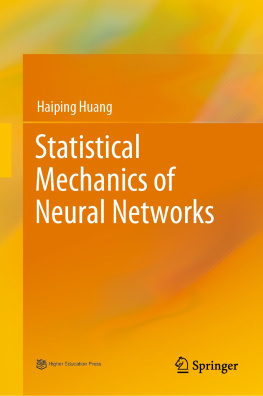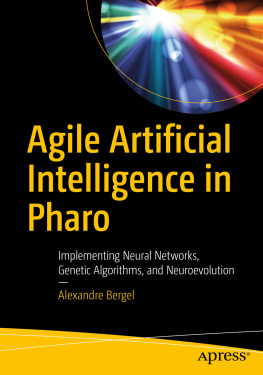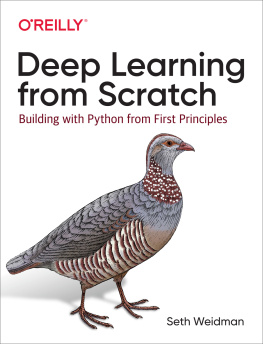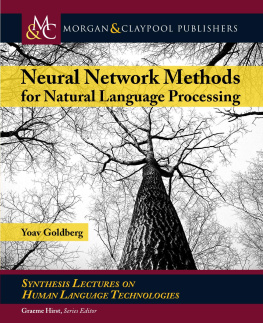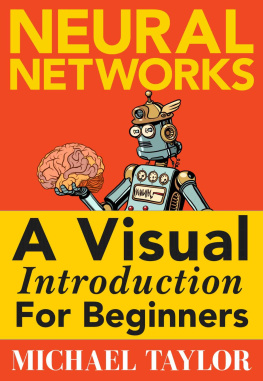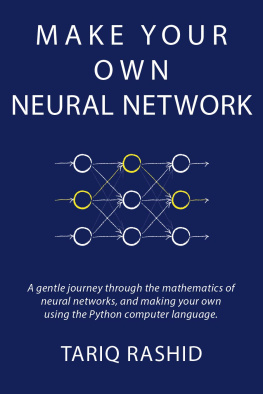Copyright 2021 Amiina Bakunowicz
All rights reserved
The characters and events portrayed in this book are fictitious. Any similarity to real persons, living or dead, is coincidental and not intended by the author.
No part of this book may be reproduced, or stored in a retrieval system, or transmitted in any form or by any means, electronic, mechanical, photocopying, recording, or otherwise, without express written permission of the publisher.
ISBN-13: 9781234567890
ISBN-10: 1477123456
Cover design by: Art Painter
Library of Congress Control Number: 2018675309
Printed in the United States of America
Computation in Architectural Design: Neural Networks and Genetic Algorithm
Amiina Bakunowicz
ARB RIBA BS(Hons) MSc(1st)
This book researches and describes one of the algorithmic design methods of the architectural metamorphosis evolved by Neural Networks and Genetic Algorithm Python script. For a short demonstration of the code, please visit
https://youtu.be/ Va7kXuoIq-c
Amiina Bakunowicz is a founder, managing director, a researcher and a senior executive architect of ArchiLAB7 (www.archilab7.com), an architectural practice that specialises in Eco-Smart Wellness Architectural design.
Eco-Smart Wellness Architectural design uses unique techniques the incorporate:
Low-carbon footprint design principles;
Algorithmic (or computational design);
Biophilic architectural design;
Golden Section (Fibonacci) geometry.
It is an advanced approach to architectural design of buildings and outdoor spaces that enhances their occupiers both physical and emotional well-being via creating safe, visually appealing and comfortable internal and external environments (including BREEAM and Passivhaus accreditations).
Table of Contents:
Chapter 1. Preface
Chapter 2. Introduction
2.1 The New Aesthetics and the Ecology of Design
2.2 Coding vs Traditional Design Methods
Chapter 3. The Concept of the Architectural Problem
3.1 Architectural Scenario
3.2 Proposed Solution to the Architectural Problem
3.3 Other Ways of Solving Similar Problems?
3.3.1. Electrical Graph Approach
3.3.2. Physically based modelling
Chapter 4. Classic Genetic Algorithm
4.1 Traditional Genetic Algorithm
4.1.1. Brief Description
4.1.2. Evolutionary Embryogenies.
4.2 Classic GA for the Current Architectural Scenario
4.2.1 Description of the Code
4.2.1.1. Original CA Model and Body-Plan
4.2.1.2. The First Generation
4.2.1.3. The Fitness Function
4.2.1.4. The Process of Selection
4.2.1.5. Crossover and Mutation
4.2.2 Outcome of the Algorithm
4.3 Examples of GA Applications in Architecture
Chapter 5. Self-Organising Maps and Genetic Algorithm
5.1 Artificial Neural Networks and Self-Organising Maps
5.2 Introducing SOM to the Classic GA
5.2.1 Why Combining GA with SOM?
5.2.2 Managing the Expanded Choice
5.2.3 The Evaluation of the Aesthetics
5.3. The Evolution of the Proposed Code
5.3.1. Stage 1.Classic GA for the Current Architectural Scenario
5.3.2. Stage 2. Adding Golden Ratio to the Fitness Criteria
5.3.3. Stage 3. Introducing Self-Organising Maps to the Genetic Algorithm
5.3.4. Stage 4. Turning Chromosomes into Neurons and Back
5.3.5. Stage 5. Co-evolving Threshold of the Fitness Factor Components
5.3.6. Stage6. Optional Selection Method
5.4. The Final Algorithm
5.4.1. The Structure of the Algorithm
5.4.1.1. Original CA Model and Body-Plan
5.4.1.2. The First Generation
5.4.1.3. Introducing Self-Organising Maps
5.4.1.4. The Fitness Function
5.4.1.5. Selection Options
5.4.1.5.1. The final decision-making rules of the proposed algorithm
5.4.1.5.2. Selection Option 1: Optimised Random Selection by Clusters
5.4.1.5.3. Selection Option 2: Artificial Selection and Evaluation of Aesthetics
5.4.1.5.4. Selection Option 3: Goldberg Roulette
5.4.1.6. Crossover
5.4.1.7. Mutation
5.4.1.8. The following Generations
5.4.1.9. Visualisation of the Search Space by Clustering and Evolution of Colour
5.4.2. Main Results and Observations
5.5. Advantages and Disadvantages of GA-SOM
5.6. Further Research
5.6.1 Parameterisation of the Body-Plan
5.6.2 Swarms and SOM Pattern Recognition
5.6.3 Discovering the Potential of Clusters
5.6.4. Co-Evolution Instead of Fitness Criteria
5.6.5. Exploring Other Ways in Which CA Can Generate Body-Plans
5.6.6. Other Visualisation Techniques of the Search Space
5.6.7. Adapting Genetic Operators to Evolve the Evolvability
Chapter 6. Conclusion
Chapter 7. References
Chapter 8. FurtherReading
Chapter 9. Appendixes
Appendix 1. Traditional Genetic Algorithm: a Brief Description
Appendix 2. Comparing the Types of the Evolutionary Embryogenies
Appendix 3. Example of a SOM Algorithm Application in 3D Modelling and Its Applications
Appendix 4. Piasecki and Sean's Wundt Curve Experiment
Appendix 5. First Ever SOM for Multi-Objective Evolutionary Algorithm
Appendix 6. Brudaru's Cellular Genetic Algorithm with Communicating Grids and SOM
Appendix 7. Kita's Real-Coded Genetic Algorithm (RCGA) and SOM
Appendix 8. Optional Body-Plans for the Proposed Algorithm
Appendix 9. Proposed Algorithm (Python)
... Game did not display perfection to the outward eye. Rather, it guided the player
Herman Hesse, 1943 The Glass Bead Game
Chapter 1. Preface
Since the dawn of Computer Aided Design for a long time architects were coming up with digitally modelled projects that were very radical, but impossible to build. Later on with the development of the fabrication techniques a lot of the designs have materialised. Currently, architects started using computational methods to re-evaluate designs. In addition to that there always has been the urge for architectural significance and designs became very economic and performance- orientated. Thus the exploration of the alternative computational ways of the architectural morphogenesis was left behind.
I would like to propose a possible solution to the form-finding challenge in a given architectural context by scripting. This paper describes a design process that mostly uses code that combines Genetic Algorithm and Self-Organising Maps and evolves a predetermined Cellular Automata model. A computer forms a team with an architect to develop a design, where the solution is formed gradually during the process of running the algorithm. Together, the designer and the machine go through the architectural design procedure starting from the phase at which the appraisal is carried out, concepts are finalised and the basic mass study is done until both are satisfied with the algorithm's outcome. The eventual model can be then given back to the architect for final adjustments and detailing.
The proposed algorithm has two tasks. Firstly, based on the information available after the completed initial design stages, to develop a schematic body-plan of the architectural model and parameterised it. Secondly, applying the principles of the processes of natural evolution and biological neural networks, use the genetic algorithms (GA) and neural Self-Organising Maps (SOM) to evolve optimal solutions.
This paper will concentrate mostly on the second stage of the algorithm, where the self- organising mapping will be applied to each generation of the alternated body-plan in order to widen, classify, structure and exploit the search space of the GA. I believe that the algorithm can create and amplify the synthetic intuition and give a designer yet another powerful tool and a new skill to be applied in the process of the forming the matter around the architectural concept. Also by structuring and optimising the possibilities space I would like to test if SOM could help to speed up the process of finding the optimal solution and avoid premature convergence.


